Mercury
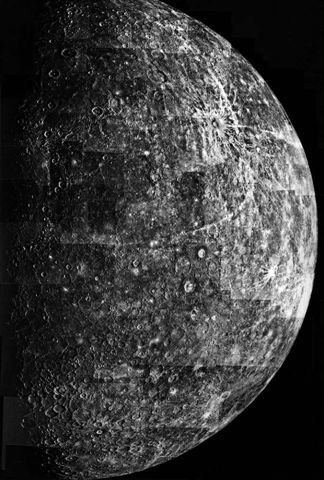
Photomosaic of Mercury by Mariner 10.
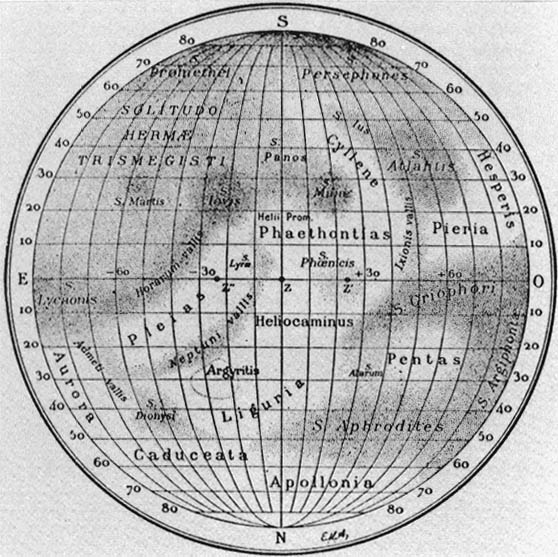
Antoniadi's map of Mercury, c. 1920
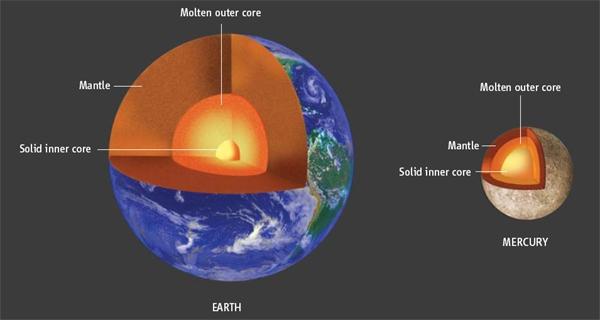
Interiors of Earth and Mercury compared.

This image was taken today by NASA's MESSENGER spacecraft at a distance of approximately 17,000 miles following the spacecraft's closest approach to Mercury. It shows features as small as 6 miles in size. Similar to previously mapped portions of Mercury, this hemisphere appears heavily cratered. It also reveals some unique and distinctive features. On the upper right is the giant Caloris basin, including its western portions never before seen by spacecraft. Formed by the impact of a large asteroid or comet, Caloris is one of the largest, and perhaps one of the youngest basins in the solar system.

MESSENGER acquired this image on 14 January 2008, as part of a mosaic that covers much of the sunlit portion of a hemisphere not view by previous spacecraft. Images such as this can be read in terms of a sequence of geological events and provide insight into the relative timing of processes that have acted on Mercury's surface in the past. The double-ringed crater at upper right of this image appears to be filled with smooth plains material, perhaps volcanic in nature. This crater was subsequently disrupted by the formation of a prominent cliff, the surface expression of a major crustal fault system that runs alongside part of its southern rim. This may have led to the uplift seen across a portion of the crater's floor. A smaller crater in the upper left of the image also has been cut by the cliff, showing that the fault beneath the cliff was active after both of these craters had formed.
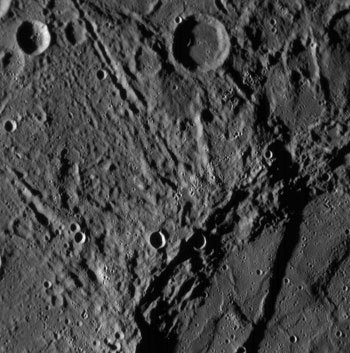
This image obtained by MESSENGER reveals a variety of intriguing surface features, including craters as small as 900 feet across. The image also shows landscapes near Mercury's equator on the side of the planet never before imaged by spacecraft. These highly detailed close-ups enable planetary geologists to study the processes that have shaped Mercury's surface over the past 4 billion years. One of the highest and longest scarps cliffs yet seen on Mercury curves from the top center down across the right side of this image. Great forces in Mercury's crust have thrust the terrain occupying the left two-thirds of the picture up and over the terrain to the right. An impact crater has subsequently destroyed a small part of the scarp near the top of the image. This image was taken from a distance of 3,600 miles from surface and shows a region approximately 100 miles across.
Mercury is the smallest and innermost planet of the Solar System. It is surpassed in size (but not in mass) by both Ganymede and Titan. In ancient Greece it had two names – Apollo for its appearance as a morning star and Hermes as an evening star – although Greek astronomers knew that a single body was involved. Being named after the fleet-footed god Hermes, or its Roman equivalent Mercury, is especially apt as the planet races around the Sun at an average speed of 48 kilometers per second, completing one circuit in 88 days.
Mercury is notoriously difficult to observe, being both small and always in the glare of the Sun as seen from Earth. At best it can be studied telescopically for a few weeks each year, near to sunrise or sunset. However, we now know a great deal more about it because of observations made by spacecraft that have flown past it or gone into orbit around it.
| distance from Sun (mean) | 57.9 million km (35.9 million mi, 0.387 AU) |
| orbital period | 87.969 days |
| orbital eccentricity | 0.206 |
| orbital inclination | 7.00° |
| equatorial diameter | 4,879 km (3,032 mi), 0.382 × Earth |
| mass (Earth=1) | 0.055 |
| mean density | 5.43 g/cm3 |
| axial period | 58.65 days |
| axial inclination | ~0.01° |
| atmospheric composition | negligible – traces of sodium, helium, hydrogen, oxygen |
| max. temperature (day) | 427°C (801°F) |
| min. temperature (night) | -183°C (-297°F) |
| surface gravity (Earth=1) | 0.38 |
| escape velocity | 4.3 km/s (15,480 km/h, 9,621 mph) |
| albedo | 0.11 |
| number of moons | 0 |
Rotation
Until the 1960s it was thought that Mercury's day (the time it takes to spin on its axis) was the same length as its year (the time it takes to complete one orbit) so that it always kept one face to the Sun. However, Doppler radar measurements in 1965 showed that Mercury actually rotates three times in two of its years.
This fact and Mercury's highly elliptical orbit would lead to strange effects for an astronaut on the surface. At some longitudes the Sun would appear to rise briefly, set, and rise again before traveling westward across the sky. At sunset, the Sun would set, rise again briefly, and then set again. In other places, an observer could watch the Sun come to a standstill and then move backward for a while, before continuing its original motion, having done a complete loop.
Earlier observations
From his observations of the innermost planet between 1779 and 1813, Johann Schröter deduced the existence of a mountain 20 kilometers high and a Mercurian rotation period of just over 24 hours. Later, the English astronomer William Denning (1848–1931) reported surface markings "so pronounced that they suggest an analogy with those of Mars" and adjusted the period to 25 hours. But it was Giovanni Schiaparelli's suggestion, that Mercury's day might be 88 Earth days long, the same as its year, which was generally accepted from the 1880s until as recently as the early 1960s. Concomitant with this hypothesis of gravitational lock was the intriguing idea of a (possibly habitable) "twilight zone".
Based on the assumption that Schiaparelli's period was correct, Eugene Antoniadi produced a map of dark and light areas of the planet, complete with wonderfully evocative names, such as Aurora, Apollonia, Pieria, Liguria, and Cyllene. The first sign of trouble for the Schiaparellian model came in 1962, when measurements by W. E. Howard and his colleagues at Michigan revealed that the night side of Mercury was warmer than it should have been if it never faced the Sun. Three years later, radar measurements, by Gordon Pettengill and Rolf Dyce of Cornell University using the Arecibo radio telescope, showed conclusively that Mercury is not locked in position relative to the Sun. It is in a gravitational resonance, but one in which its axial rotation period is about 58.6 Earth days, or two thirds of its orbital rotation period.
Orbit
Although Mercury's mean distance from the Sun is 57,910,000 kilometers (0.387 AU), its orbit is very elongated. The range from perihelion to aphelion is 46 to 70 million kilometers.
Mercury's perihelion precesses around the Sun at a rate that 19th century astronomers couldn't properly explain. The 'advance' of the perihelion was 476 arcseconds per century – 42.6" more than expected. This discrepancy remained a nagging problem for many decades, and it was even suggested that the answer might lie in the existence of an intra-Mercurian planet, sometimes called Vulcan. In the end, the puzzle was solved in much more dramatic style, by applying a new theory of gravity: Einstein's general theory of relativity.
Interestingly, Mercury is the closest planet to Earth on average. Mercury is, one average, 155.4 million kilometers from Earth, Venus is 170.5 million kilometers away, and Mars is 254.6 million kilometers away.
Despite being fairly close to us, Mercury is one of the least-studied planets in the solar system. Until 2008, it had been visited by only one spacecraft, Mariner 10, which flew by three times in 1974 and 1975, mapping 45% of the surface. Mariner observed a world similar in general respects to the Moon: heavily cratered but with regions of relatively smooth plains, some of which may be the result of ancient volcanic activity, others due to the deposition of ejecta from cratering impacts. Its most distinctive features is the Caloris Basin, a colossal, multiringed basin about about 1,350 kiometers (840 miles) in diameter, whose inner floor contains mostly smooth plains, known as Caloris Planitia, but also many ridges and fractures, some of them radial and others arranged in two or three concentric rings. Its name, meaning "basin of heat," stems from the fact that it lies near the subsolar point when Mercury is at perihelion and thus can experience temperatures as high as 700 K.
There are also great escarpments, up to 1,500 kilometers long and 3 kilometers high, some of which slice through the rings of craters and other features in a way that shows they were formed by compression of the crust when Mercury's interior cooled and shrank. Estimates suggest that the planet's surface area decreased by about 0.1% and its radius by about 1 kilometer.
Radar images taken by astronomers at the Jet Propulsion Laboratory and the California Institute of Technology in 1991 suggest that the polar regions of Mercury may be covered with patches of water-ice. Although this seems impossible due to the planet's sizzling heat, the polar regions receive very little sunlight and may get as cold as -148°C.
Surface features
Caloris Basin
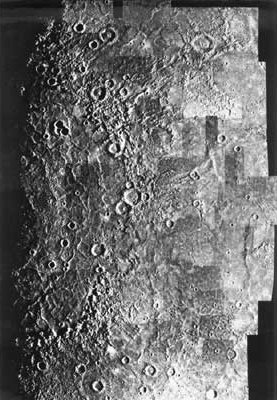 |
| Part of the Caloris Basin. |
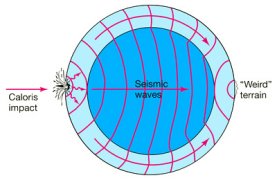 |
| Likely explanation of how the Caloris Basin and antipodal "weird" terrain formed. |
Seen above is part of the enormous Caloris Basin on Mercury, which is thought to be similar to the large circular basins found on the Moon. It was probably formed by a giant impact early in Mercury's history, and then subsequently filled by lava flows. The nature of the wrinkle ridges on its floor is arguable: some scientists claim tectonics while others suggest they are due to volcanic flows escaping from fractures.
At the antipodal point to the Caloris Basin is found "weird" hilly terrain with lineated features. It is thought that the shock wave produced by the Caloris impact probably reflected and focused to the antipodal point (see lower diagram), thus jumbling the crust and breaking it into a series of complex blocks.
Interior
Mercury is the second densest major body in the solar system, after Earth, pointing to a relatively enormous iron core with a radius of 1,800 to 1,900 kilometers – proportionately much larger than Earth's and making up most of the planet. Above this is a relatively thin silicate mantle and crust, only 500 to 600 kilometers in total from top to bottom.
Mercury has a weak magnetic field about 1% as strong as Earth's. Recent research into irregularities in the rate of Mercury's spin suggest that this magnetic field may be due to a molten outer core.
Atmosphere
Mercury has an extremely thin atmosphere, about one trillionth the density of Earth's, composed mainly of atoms of argon, neon, and helium that have been blasted off the surface by the solar wind.
Current and future probes
Only two spacecraft have been sent to explore Mercury, although a third is on its way. The first was Mariner 10, which flew past the innermost planet three times in 1974 and 1975. Then, in 2004, NASA launched its MESSENGER spacecraft, which successfully went into orbit around Mercury in 2011. It spent four years circling the planet before being intentionally crashed into the surface.
Now the BepiColombo spacecraft, a joint mission of the European and Japanese space agencies, is on its way. Launched in October 2018, BepiColombo will arrive at Mercury in late 2025. Its two orbiters will then spend at least a year, and possibly two, gathering data on the planet's surface, interior, magnetic field, and exosphere.
Speculation about life on Mercury
The proximity of Mercury to the Sun did not deter some pluralists, prior to the twentieth century, from advocating the existence of life on the innermost planet. However, speculations of a more scientific nature followed Schiaparelli's attempts, in the 1880s, to map the Mercurian surface and his conclusion that Mercury always kept the same face toward the Sun. This implied extreme permanent differences in temperature between the perpetually sunlit side of the planet, which would be unbearably hot, and the endlessly dark side, which would be almost unimaginably frigid. It also, crucially, implied the existence of a "twilight zone" where the temperature would be permanently moderate. Here, in this narrow margin between ever-lasting day and ever-lasting night, some astronomers speculated, there might exist primitive forms of Mercurian life. Such hopes disappeared, however, as it became clear that Mercury lacks any substantial atmosphere.


